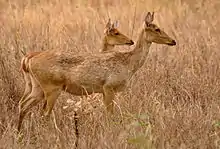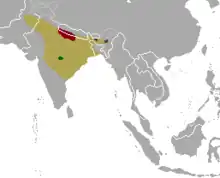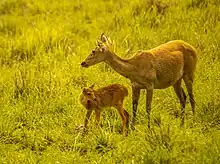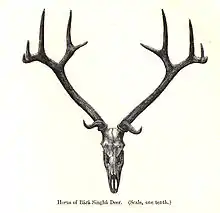Barasingha
The barasingha (Rucervus duvaucelii), sometimes barasinghe, also known as the swamp deer, is a deer species distributed in the Indian subcontinent. Populations in northern and central India are fragmented, and two isolated populations occur in southwestern Nepal. It has been extirpated in Pakistan and Bangladesh, and its presence is uncertain in Bhutan.[1]
| Barasingha | |
|---|---|
 | |
| male | |
 | |
| adult female and yearling | |
| Scientific classification | |
| Domain: | Eukaryota |
| Kingdom: | Animalia |
| Phylum: | Chordata |
| Class: | Mammalia |
| Order: | Artiodactyla |
| Family: | Cervidae |
| Subfamily: | Cervinae |
| Genus: | Rucervus |
| Species: | R. duvaucelii |
| Binomial name | |
| Rucervus duvaucelii | |
 | |
| Historic range (yellow); relict populations: duvaucelii (red); branderi (green); ranjitsinhi (blue) | |
The specific name commemorates the French naturalist Alfred Duvaucel.[3]
The swamp deer differs from all other Indian deer species in that the antlers carry more than three tines. Because of this distinctive character it is designated bārah-singgā, meaning "twelve-horned" in Hindi.[4] Mature stags usually have 10 to 14 tines, and some have been known to have up to 20.[5]
In Assamese, barasingha is called dolhorina; dol meaning swamp.
Characteristics
The barasingha is a large deer with a shoulder height of 44 to 46 in (110 to 120 cm) and a head-to-body length of nearly 6 ft (180 cm). Its hair is rather woolly and yellowish brown above but paler below, with white spots along the spine. The throat, belly, inside of the thighs and beneath the tail is white. In summer, the coat becomes bright rufous-brown. The neck is maned. Females are paler than males. Young are spotted. Average antlers measure 30 in (76 cm) round the curve with a girth of 5 in (13 cm) at mid beam.[6] A record antler measured 104.1 cm (41.0 in) round the curve.[5]
Stags weigh 170 to 280 kg (370 to 620 lb). Females are less heavy, weighing about 130 to 145 kg (287 to 320 lb).[7] Large stags have weighed from 460 to 570 lb (210 to 260 kg).[4]
Distribution and habitat
Swamp deer were once-common in many areas, including parts of the Upper Narmada Valley and to the south, in Bastar, prior to the 19th century.[6] They frequent flat or undulating grasslands, floodplains and marshes, and generally stay on the outskirts of forests. At times, they are also found in open forest.[4] In the 1960s, the total population was estimated to be between 1,600-2,150 individuals in India, with about 1,600 in Nepal. Today, the distribution is further reduced and fragmented, due to major losses in the 1930s–1960s following unregulated hunting and conversion of large tracts of habitat into cropland.
In Nepal, they can be primarily found in the western areas of the country, south of the Himalayas, in Shuklaphanta and Bardiya National Parks. Within India, barasingha can be found in six localities in Uttar Pradesh. They are found in Kanha National Park, in Madhya Pradesh, and have also been observed across the state border in Chhattisgarh (near to Dhamtari),[8] likely the most southerly extent of their distribution. They are regionally extinct in West Bengal,[9] and are also likely extirpated from Arunachal Pradesh, Bihar, Jharkhand, Meghalaya, Nagaland and Odisha.[10] A few barasingha still survive in Assam's Kaziranga and Manas National Parks.[11][12][13][14]
In 2005, a small population of about 320 individuals was discovered in the Jhilmil Jheel Conservation Reserve in Haridwar district, Uttarakhand, on the east bank of the Ganges. This likely represents the most northerly limit of the species.[15][16]
Distribution of subspecies
Three subspecies are currently recognized:[17]
- Western swamp deer R. d. duvauceli (Cuvier, 1823) – the nominate subspecies, and most abundant, this water-loving deer has splayed hooves and is adapted to the flooded grassland habitat of the Indo-Gangetic plain;[18] in the early 1990s, populations in India were estimated at 1,500–2,000 individuals, and 1,500–1,900 individuals in the Shuklaphanta Wildlife Reserve of Nepal;[9] the latter population reached 2,170 individuals, including 385 fawns, in spring 2013.[19] While few zoos or wildlife parks keep barasingha, internationally, the San Diego Zoo (and its connected Safari Park), in California, United States, has successfully cared-for and bred the western barasingha since the 1970s. Much of their breeding success has been due to the sprawling, naturalistic environment the animals live in, a 150-acre field exhibit called the “Asian Plains”—a setting not unlike their native habitat on the Indo-Gangetic plain. Other Indian species that are mixed with the swamp deer include bharal, blackbuck, chinkara, chital, gaur, hog deer, Indian rhinoceros, nilgai, sambar, tahr and wild boar, as well as sarus cranes.
- Southern swamp deer R. d. branderi (Pocock 1943) – has hard hooves and is adapted to hard ground in open sal forest, with a grass understorey;[18] survives only in the Kanha National Park, an area between states, to the west of Chhattisgarh and east of Madhya Pradesh. The population numbered about 500 individuals in 1988; 300–350 individuals were estimated at the turn of the century;[9] and 750 in 2016. It was reintroduced into Satpura Tiger Reserve.[20] There is a herd of southern barasingha in the United Kingdom, at the Port Lympne Wild Animal Park, Kent, England.[21]
- Eastern swamp deer R. d. ranjitsinhi (Grooves 1982) – is only found in Assam, where the population numbered about 700 individuals in 1978; 400–500 individuals were estimated in Kaziranga National Park at the turn of the century.[9] After a census conducted in 2021, 868 individuals were estimated in the park, with a further 121 in Manas National Park.[22]
Ecology and behaviour

Swamp deer are mainly grazers.[4] They largely feed on grasses and aquatic plants, foremost on Saccharum, Imperata cylindrica, Narenga porphyrocoma, Phragmites karka, Oryza rufipogon, Hygroryza and Hydrilla. They feed throughout the day with peaks during the mornings and late afternoons to evenings. In winter and monsoon, they drink water twice, and thrice or more in summer. In the hot season, they rest in the shade of trees during the day.[9]
In central India, the herds comprise on average about 8–20 individuals, with large herds of up to 60. There are twice as many females than males. During the rut they form large herds of adults. The breeding season lasts from September to April, and births occur after a gestation of 240–250 days in August to November. The peak is in September and October in Kanha National Park.[7] They give birth to single calves.[7]
When alarmed, they give out shrill, baying alarm calls.[5]
Compared to other deer species, Barasingha are more relaxed when it comes to guarding. They have fewer sentries and they spend most of their time grazing, unlike deer species like Spotted deer or Sambar deer.[23]
Threats

The swamp deer populations outside protected areas and seasonally migrating populations are threatened by poaching for antlers and meat, which are sold in local markets. Swamp deer lost most of its former range because wetlands were converted and used for agriculture so that suitable habitat was reduced to small and isolated fragments.[9] The remaining habitat in protected areas is threatened by the change in river dynamics, reduced water flow during summer, increasing siltation, and is further degraded by local people who cut grass, timber and fuelwood,[1] and by illegal farming on government land.[24]
George Schaller wrote: "Most of these remnants have or soon will have reached the point of no return."[7]
Conservation
Rucervus duvaucelii is listed on CITES Appendix I.[1] In India, it is included under Schedule I of the Wildlife Protection Act of 1972.[9]
An attempt to translocate some individuals to Chitwan National Park in Nepal was unsuccessful.[25]
In culture
Rudyard Kipling in The Second Jungle Book featured a barasingha in the chapter "The Miracle of Purun Bhagat" by the name of "barasingh". It befriends Purun Bhagat because the man rubs the stag's velvet off his horns. Purun Bhagat then gives the barasinga nights in the shrine at which he is staying, with his warm fire, along with a few fresh chestnuts every now and then. Later as pay, the stag warns Purun Bhagat and his town about how the mountain on which they live is crumbling.
Barasingha is the state animal of the Indian states of Madhya Pradesh and Uttar Pradesh.[28]
See also
References
- Duckworth, J.W.; Kumar, N.S.; Pokharel, C.P.; Sagar Baral, H. & Timmins, R. (2015). "Rucervus duvaucelii". IUCN Red List of Threatened Species. 2015: e.T4257A22167675. doi:10.2305/IUCN.UK.2015-4.RLTS.T4257A22167675.en. Retrieved 15 January 2022.
- Grubb, P. (2005). "Species Rucervus duvaucelii". In Wilson, D.E.; Reeder, D.M (eds.). Mammal Species of the World: A Taxonomic and Geographic Reference (3rd ed.). Johns Hopkins University Press. pp. 668–669. ISBN 978-0-8018-8221-0. OCLC 62265494.
- Cuvier, G. (1823). Recherches sur les ossemens fossiles de quadrupèdes. Vol. Tome Quatrième (Nouvelle édition ed.). Paris, Amsterdam: Dufour & d'Ocagne.
- Lydekker, R. (1888–1890). The new natural history Volume 2. Printed by order of the Trustees of the British Museum (Natural History), London.
- Prater, S. H. (1948). The book of Indian animals. Oxford University Press. (10th ed.)
- Blanford, W. T. (1888–1891). The fauna of British India, including Ceylon and Burma. Mammalia. Taylor and Francis, London.
- Schaller, G. B. (1967). The Deer and the Tiger – A Study of Wildlife in India. Chicago, IL, USA: University Chicago Press. p. 93–133. ISBN 0-226-73633-4.
- "Barasingha in March 2013 by janconl". inaturalist.org. April 2020.
- Qureshi Q, Sawarkar VB, Rahmani AR, Mathur PK (2004). "Swamp Deer or Barasingha (Cervus duvauceli Cuvier, 1823". Envis Bulletin. 7: 181–192.
- Choudhury, A. U. (2003). The mammals of Arunachal Pradesh. Regency Publications, New Delhi ISBN 81-87498-80-3.
- Choudhury, A. U. (1997). Checklist of the mammals of Assam. 2nd ed. Gibbon Books & Assam Science Technology & Environment Council, Guwahati, India. ISBN 81-900866-0-X
- Choudhury, A. U. (2004). Kaziranga: Wildlife in Assam. Rupa & Co., New Delhi.
- Choudhury, A. U. (1987). "Railway threat to Kaziranga" (PDF). Oryx. 21 (3): 160–163. doi:10.1017/S0030605300026892.
- Choudhury, A. U. (1986). Manas Sanctuary threatened by extraneous factors. The Sentinel.
- Tewari, R. and Rawat, G.S. (2013). Activity pattern and diurnal time budget of Swamp Deer (Rucervus duvaucelii duvaucelii) in Jhilmil Jheel Conservation Reserve, Haridwar, Uttarakhand, India. NeBIO 4 (3): 36–40.
- Nandy, S., Kushwaha, S.P.S. and Gaur, P. 2012. Identification of Swamp deer (Cervus duvauceli duvauceli Cuvier) potential habitat in Jhilmil Jheel Conservation Reserve, Uttarakhand, India using multi-criteria analysis. Environmental Management 49 (4): 902–914.
- Groves, C. (1982). "Geographic variation in the Barasingha or Swamp Deer (Cervus duvauceli)". Journal of the Bombay Natural History Society. 79: 620–629.
- Pocock R. (1943). The larger deer of British India. Journal of the Bombay Natural History Society 43: 553–572.
- The Himalayan Times (2013). Shuklaphanta sees increase swamp deer number. Kanchanpur, 19 April 2013.
- Shukla, R. (2017). "Barasingha breaks new ground". Frontline. Kanha Tiger Reserve. Retrieved 3 September 2017.
- "Picture of Barasingha/swamp deer / Rucervus duvaucelii branderi at Port Lympne Wild Animal Park". www.ZooInstitutes.com. Retrieved 5 March 2023.
- Goswami, Roopak (20 January 2022). "Can a big flood push Kaziranga's Eastern Swamp Deer to extinction?". EastMojo. Assam. Retrieved 12 November 2022.
- Menon, Vivek. Indian Mammals: A Field Guide.
- Dabas, H. (12 December 2016). "As Ganga water level dips, farmers encroach land for farming". The Times of India. Bijnor. Retrieved 22 December 2016.
- Abhaya Raj Joshi (27 July 2023). "Translocation hurdles prompt new efforts to save rare swamp deer in Nepal". Mongabay. Retrieved 4 August 2023.
- McCarthy, A., Blouch, R., Moore, D., and Wemmer, C. M. (1998). Deer: status survey and conservation action plan IUCN Deer Specialist Group. IUCN, Gland, Switzerland.
- Long, John L. (2003). Introduced Mammals of the World. Collingwod, Australia: CSIRO. p. 411. ISBN 0-643-06714-0.
- "State Animals, Birds, Trees and Flower". www.pannatigerreserve.in. Retrieved 4 April 2018.
Further reading
- M. Acharya, M. Barad, S. Bhalani, P. Bilgi, M. Panchal, V. Shrimali, W. Solanki, D.M. Thumber. Kanha Chronicle. Centre for Environment Education, Ahmedabad in collaboration with the United States National Park Service.
